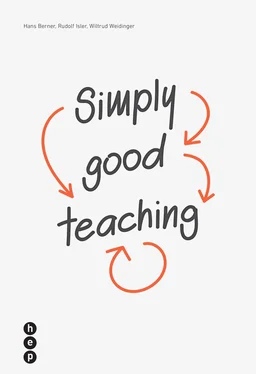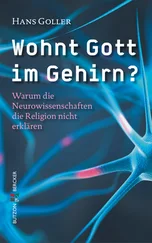5 Performance expectation
There is a consensus in the educational science community that high performance expectations and an optimistic estimation of goal attainment by parents as well as teachers are of greatest importance for the learning success of children and adolescents. It is therefore not surprising that Hattie, Helmke, and Meyer all emphasize the importance of challenging and transparent performance expectations. The expectations should be oriented along guidelines or educational standards and attained by a teaching curriculum that corresponds to students’ capacity for learning. In doing so, they should not only strive for professional competences but also interdisciplinary competences. Without education-oriented feedback about the educational progress, performance expectations are only of limited benefit (see chapter 8). Additionally, Helmke emphasizes that the focus must be on the demonstrable and lasting effect of teaching, which renders regular monitoring of learning progress with all diagnostic tools and means of assessment indispensable. This must occur, however, without neutralizing the element of “only as many performance situations as necessary” from the characteristic learning atmosphere . Finally, it remains to be said that Hattie’s meta-analysis leads to the same result, but with the additional factor of teacher engagement and enthusiasm for the subject as an effective element of performance expectation as well as motivation. Challenging performance expectations should not lead to excessive demands for students. In our view, this problem is well recognized in the schools, and the risk is rather that the students’ high performance ability is underestimated and that they are not confronted with assignments that reflect an adequate appreciation of their possibilities.
6 Clarity in content and structure
There is a broad consensus among the three authors that clarity is an extremely important and effective characteristic of good teaching. For one, it concerns clearly defined goals and content (see chapter 9). Furthermore, the work method should be plausible and with a transparent organization of the learning process. The task assignments must be clear and understandable and should include possible learning aids with organizing clues (preview, summary, advance organizer etc., see chapter 2, p. 59). Ultimately, clarity and obligation are also important in securing results. An additional aspect of clarity concerns language. It should be appropriate in terms of vocabulary and technical terminology and factually correct. Moreover, conciseness of language, clear diction, adequate rhetoric, correct grammar, straightforward sentences and acoustic comprehensibility are also important.
7 “Rhythmization” and articulations
Hattie has above all pointed out that rhythmized practicing has a significantly higher effect than cumulative, bundled practicing. Helmke and Meyer do not postulate a special characteristic of rhythmized teaching and for its articulation (articulation = chronological structuring of teaching in phases). However, both are included in other characteristics, such as in the preceding characteristic clarity: the demand for alternating activities in the classroom which enhance learner concentration and absorption capacity and prevents monotony and offers variation. This remains uncontested. The beginning and end of a class session should be viewed especially carefully (see p. 36). Aside from the rather experience-oriented articulation, as proposed by Grell and Grell,11 which allows for a meaningful sequence for almost any classroom session, there are also scientifically elaborated concepts, such as the one by Hans Aebli,12 which is referenced under the acronym PADUA and sketches out a sequence for entire lesson units (see p. 37). Also useful is the AVIVA model13, which features five phases of good teaching as well and was developed primarily for older students up to vocational school age.
8 Variety of offerings and diversity of methods
The variety of subject offerings and the diversity of methods should be understood as a supplement to the previously discussed characteristics. Meyer and Helmke are in favor of a student oriented, subject and learning objective-appropriate variation of teaching methods and social forms and for a balanced combination of major methodological forms. A teacher’s vast repertoire of staging techniques and variety of approaches are to be welcomed, but all too many variations appear to be equally problematic as a didactic “monoculture”. From Hattie’s point of view it remains to be added that the concept of reciprocal learning shows a particularly high learning effect and, concurring with Meyer, that metacognitive strategies and learning techniques – consideration of the meta level of learning – have an additional positive effect (see chapters 3 and 4).
9 Student orientation and support
The characteristic of student orientation and support is considered effective by Helmke as well as Hattie. The point is that instructors should not only be contact persons for technical-curricular issues but also personal contact partners, and that teachers take the learners and their statements and questions seriously. Ideally, students are polled about the teaching process and participate within reason in decisions concerning the structure and content of instruction. In our view, student feedback is part of a modern culture of reflection on teaching (see chapter 10, 309 f.).
10 Heterogeneity and individual promotion
Central to this characteristic is a sensitive approach with heterogeneous learning requirements and student personalities with special care that differences in social, linguistic, and cultural areas are recognized and respected. To adequately respond to heterogeneity, care must be taken to adjust the instructional speed and degree of difficulty to the respective requirements of individual students or entire student groups. This requires individual learning assessments and coordinated promotion plans, an internal differentiation of instruction, variation of subject, generic goals, and contents, particularly a furthering of children and adolescents from groups at risk. Referencing this characteristic, Helmke talks about fit and Meyer refers to individualization. The effects of individual furthering in Hattie’s study are only referenced as part of other effects.
11 Consolidation and intelligent practicing
As a memory psychological condition for work with demanding assignments, it is necessary to practice and master basic skills to the point of automaticity. On the other hand, it is also necessary to include in the instructional process a multitude of assignments that require not just mechanical but “intelligent” practice. Tailor-made practice assignments, targeted assistance, good framework conditions, and a high variation of practice opportunities are part of this characteristic, which is considered equally important by all three authors. Instructional methodology is of central importance for the formulation of learning-conducive assignments in all school subjects. Finally, Hattie emphasizes that practicing increases the possibility of not just mastering a subject but also the fluency in a subject area.
12 Self-action and learning assignments
With reference to the well-known teaching researcher Franz Weinert, Helmke sums up this characteristic in a nutshell: good teaching is teaching in which more is learned than taught. Therefore, educational offerings for autonomous, self-reliant learning must be made available; all students need diverse speaking and learning opportunities where latitude rather than narrow margins and authentic questions instead of pseudo-questions should be the guiding principles. The school pedagogues Jochen and Monika Grell provide in the publication Unterrichtsrezepte 14 (educational recipes) with the chapter Das Rezept Lernaufgabe (the learning taste recipe) an appropriate, practice-oriented deeper analysis of these claims. Ultimately, homework assignments are also suitable to further independent work.
Читать дальше












